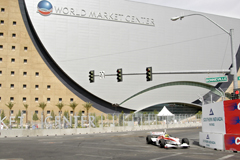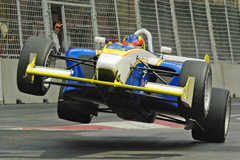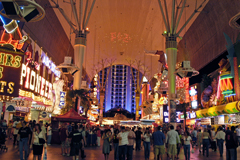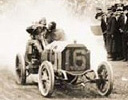Best Street Circuit In The World?
Las Vegas, Nevada, April 7 — Is Las Vegas the best street circuit in the world? Or, at the very least, the best first year street circuit in the world?
Many drivers seem to think so.
"More like a permanent circuit," Atlantic driver Robert Wickens said. "It's really wide. You have a lot of room to gather it up. You can get some good drafts here. Passing will be pretty easy."
"This is a great street course," Paul Tracy said. "This is probably one of the finest circuits - not only from a driver's standpoint. A lot of the tracks we go to, we go to the city, the city wants to have a race, but they don't want to give up too many streets, they want to limit you to a certain area where there's not a lot of traffic. A lot of the tracks we go to are compromised racetracks. They're in a parking lot. They're on streets they don't use. They make them short. Most street tracks are a mile-and-a-half to a mile point seven, which is a fairly short lap for these cars."
Atlantic driver James Hinchcliffe said, "I think this is the best first year street circuit I've seen in the world.".
Surfers Paradise always struck me as the best street circuit on the Champ Car circuit despite, or maybe because, of all the chicanes. In fact, Australia gets high marks for many of their street circuits. I always felt that Adelaide, when they hosted Formula 1, was the best in the world. And, Melbourne certainly upheld Down Under's reputation.
I like some of the older configurations of Long Beach rather than the current one, but certainly after so many years of perfecting the track, it rates pretty high. Toronto is not bad, but like other street circuits, it suffers from its narrowness. Denver, in its too short life, gets lots of kudos for the famed Mile Wide Turn.
Like any street circuit, Las Vegas does have it's point and squirt turns and short straights. The configuration around the Golden Nugget (Turns 5-8) reminds me of Turns 5,6,7 in Toronto. But outside of that and turns 9 and 10 (whose straights are a bit longer than the previous turns) the configuration is unlike typical street circuits.
There are a number of long straights and sweeping turns. Starting with the front straight, the longest on the track, a tremendous amount of speed is attained for any circuit, never mind a street circuit. Feeding this straight is a sweeping left hander after the cars come out of a tunnel from another long straight. Thus, lots of momentum is maintained.
"The Vegas track is quite cool," Dan Clarke said. "It's surprisingly fast for a street circuit, and not too bumpy."
The front straight does have two kinks in it, taking some passing opportunities away. However, they do add some technical difficulty to navigating the track. According to one driver, The first kink can be taken flat out, sort of. It's not easy, and it cannot be done if you are with another car.
 Turn 1 with the World Market Center in the background. (Photos by .)
Turn 1 with the World Market Center in the background. (Photos by .)
The last kink makes for fascinating observations. It occurs within the braking zone for Turn 1. Thus, you see all sorts of different lines through the kink as drivers are forced to brake while turning. Even more interesting, there is no consistency amongst and between the fast and slow drivers.
Paul Tracy likes to pinch the kink, braking in as straight of a line as possible. Sebastien Bourdais prefers to run the kink along the high rim. Taking Turn 1 has two options as well and again they are not always dependent on what was done in the kink, resulting in four total combinations in this complex. Bourdais stays outside taking the traditional line as if it was a normal turn, but turns in a touch early. Tracy stays away from the outside of the wall before turning in. The Team Australia drivers tend to pinch the kink, but then swing outside to prepare for the first turn.
This turn not only makes for a fascinating study in driver styles, but will add an interesting aspect to the race. The different lines can play havoc when cars go in neck and neck. And, I'm not even talking about the first lap. It will shock me if all 17 cars make it through this complex without an incident after the start.
After you get through Turn 1, which is very slow, the cars accelerate quickly and go through a sweeping right hander leading to a 90-degreee left hander which will result in hard braking again. Then, another very long straight producing extremely high speeds leading into another hard braking 90-degree turn will provide yet another opportunity for passing, before heading into the Golden Nugget complex and the more traditional street circuit portion of the track.
 Atlantic driver Alan Sciuto goes flying over the chicane.
Atlantic driver Alan Sciuto goes flying over the chicane.
Let's jump ahead to the final straight. Literally. After coming out of Turn 10, a long straight leads the drivers under an overpass before the uphill sweeping left hander onto the main straight. However, before getting to the tunnel, a chicane is in place to slow the drivers going into the tunnel. And what a chicane it is.
"It's a bit more violent than the Aussie chicane," Will Power said. "The curb is bigger. It's really hard to find the sweet spot there. It will be interesting in the race because if you kept pounding it hard, I don't know how long the car would last. You have to be smart about it, but also people can get a tow and pass you as well. If you're not quick through there, you're going to be attacked."
Some drivers definitely attack the last curb. Sometimes the middle one, too, but that can lead to dire consequences. Hopping over the final curb is certainly fast, but leads to a lot of air, bouncy landings, and slides within millimeters of the wall. I saw Simon Pagenaud hit the second curb, go out of control, run over the last curbing, causing him to be completely out of shape. It was a guaranteed crash. I was waiting for parts to be scattered all over the track. Yet somehow, and I still can't believe any human being capable of doing it especially at those speeds, the driver gained controlled of the car and kept it off the wall. Everybody's eyes were wide open as all our jaws dropped to the ground. Scintillating stuff!
Grandstand 11 is on top of the overpass looking directly down the straight at the cars coming at and under the spectators. They should probably triple the size of those stands because word has already gotten out. It was jammed packed for final qualifying as the fans get to see a thrilling show of flying, out of control cars with superhuman recoveries.
There was a nasty and dangerous bump on the track just after the chicane. After the first day, they went out and fixed the problem. Unlike other street circuits where overnight fixes tend to lead to disasters, this was done right. They jackhammered the offending portion of the track and paved a large swath of roadway to make sure the bump was not only gone but the fix did not cause a new uneven portion to be created. The new pavement held up on Saturday despite very hot temperatures and the fix was perfect, allowing the drivers to attach the chicane with impunity (and much to the delight of the fans).
"The one issue that there was with the track, the city completely fixed it right," Paul Tracy said. "They didn't just try to Band-Aid it and fix it. They tore the whole intersection out last night and repaved the intersection. That's great."
This all leads to a very important question. How long will this track last? There were many who believed, myself included, that the disruption to downtown would in the end not be acceptable to the businesses, tourists, and locals, which would doom the Vegas Grand Prix.
 The Freemont Street Experience in downtown Las Vegas in the middle of the racetrack.
The Freemont Street Experience in downtown Las Vegas in the middle of the racetrack.
I no longer believe this to be the case. Downtown has appeared to embrace the Grand Prix. It turns out, the disruptions are not that terrible. Granted, access by car to some of the casinos inside the track is limited, but foot traffic by those without tickets is not an issue. During the breaks and before and after the activities begin, car access is open outside of a few barriers that have to be driven around.
The street party on Friday night was well attended, and the local bars and eateries set up outside stands and were quite busy. Disruptions are a non-issue. I have not heard a single person complain about the race. Just the opposite, in fact.
The only opinions that now count are those of the casinos. If they feel any of the hassles were worth it, i.e., they made money off the event being here than if it were not, then the race will return. If not, then it won't. In this town, that's the way it works -- the casinos dictate the events.
Even if they have potentially the world's greatest street circuit.
"They've done a perfect job," Paul Tracy said.
Copyright © 2007 by Russell Jaslow and Deep Throttle. All Rights Reserved.
| 



